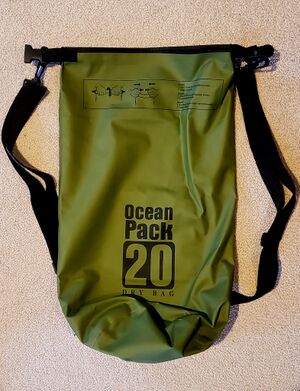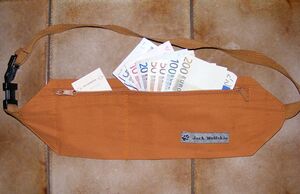Go Bag
Introduction
A Go Bag or Go Kit (sometimes known in the USA as 'Bug Out Bag') is a single bag or backpack that contains essential items when you need to suddenly leave your location. Because geographical and even political environments differ so much, there is no single go-bag solution to fit all applications. There are however items necessary to every Go Bag, regardless of context.
Building up a Go Bag is rarely a project done in a rush, not only because it's rare that all the items needed are already at hand. Rather, thought, planning and perhaps even budgeting is required. Following a 'recipe' online or buying a pre-made Go Bag kit is not advised, as you may find that it does not meet the needs of you and those you care about when you need it to. Further, almost every Go Bag outline popularised is for a single individual, rather than groups, rarely accounting for those with special needs, like the differently abled, children and elderly. For this reason, sometimes a 'Go Bag' comprises more than one bag, carrying items to support the needs of a group, and where heavier bags are carried by those physically stronger in that group.
Planning your Go Bag(s)
Take time to sit down with those in your community and make lists of needs. Invoke the thought experiment of suddenly having to leave in a hurry, thinking about daily routines and dependencies and imagining trying to meet those needs with no guarantee of shelter, shops, electricity, mobile telephony and the Internet, even a toilet. Make the imagined duration at least 3 full days. You will likely find that the list of dependencies is longer than you think.
Here is a generic example of essential needs and supplies for a single individual for 3 days of instability:
| Needs | Item | Critical | Expires |
|---|---|---|---|
| Hydration | 3L of drinking water, water filter | Y | Y |
| Food | Dehydrated or dry food or canned food | Y | Y |
| Food preparation tools | Camping stove, pot, plate or bowl | N | N |
| Fuel | Gas or fuel blocks, foraged wood | N | Y |
| Shelter | Tent or improvised tarpaulin | Y | N |
| Bedding | Sleeping bag or blanket | Y | N |
| Light | Torch and batteries, mobile phone, headlamp | Y | Y |
| Medical needs | Medicines | Y | Y |
| Toilet needs and hygiene | Toilet paper or wipes, hand sanitiser and/or soap, sanitary pads | Y | Y |
| Clothing | Clothing, raincoat, 2 changes of underwear | Y | Y |
| Emergency information | Radio and batteries, mobile phone (if network) | Y | Y |
| Emergency signal | Whistle, mirror, torch, Personal Locator Beacon | N | N |
| Emergency communication | Mobile phone (if network), walkie talkie charged batteries | Y | Y |
| Identification | Passport and/or driver's license, medical documents | Y | Y |
| Money | Cash | N | Y |
Note there are likely other needs for members of your community not met by the above list. Mobility support, like a wheelchair or crutch, may be one example, as is an oxygen tank and mask for someone with challenged breathing. Pets and their needs will need to be considered also.
Needs example: Family of 5
A family of two parents, their two children and their grandmother.
- Parent 1: Migrainer, takes prescription medicines
- Parent 2: Short sighted, glasses and contact lenses
- Grandmother: Arthritic knee, uses crutch. Gluten-intolerant
- Child 1: allergic to bees, needs antihistamine
- Child 2: diabetic, takes insulin
Example group item list
The below (draft) list is intended as a generic yet comprehensive guide for groups of up to 5 or so people providing 3 days of support. These items would be organised into bags to support both group and individual needs. A large 75L Backpack carried by the strongest person(s) in the group can carry items for the whole group, alongside their own personal items.
| Item | Per group | Per person |
|---|---|---|
| Tent(s), or tarpaulin(s) and rope, or plastic sheeting and rope and/or duct tape | X | |
| 1 sleeping bag or blanket | X | |
| 3L of fresh water in plastic bottles or hiking/sports bladder | X | |
| 1 water filtration 'straw' | X | |
| Identification in zip-lock bag or dry bag, ideally worn on person | X | |
| Paper money in small and high derivations, relative to means and economic context, ideally on person | X | |
| 1 or more camping stove, fuel and pot | X | |
| 1 full meal per day | X | |
| 300g mixed dried fruits (noting allergens) in zip-lock bags | X | |
| 1 spoon, camping bowl and cup | X | |
| First aid kit including painkillers and sterilisation spray | X | |
| 1 small traveling towell | X | |
| 1 tube SPF50+ sunscreen | X | |
| Insect repellent | X | |
| 1 roll of toilet paper and hand sanitiser in zip lock bag | X | |
| 1 reflective gold/silver rescue blanket | X | |
| 1 full change of clothes, incl. warm thermal under layers and hat | X | |
| 1 raincoat, length to knees | X | |
| 1 Wet bag for wet/dirty clothing. Strong rubbish/trash bag will do | X | |
| Toothbrush | X | |
| 1 tube toothpaste | X | |
| 1 multi-tool (LeatherMan or similar) with pliers, scissors and screwdriver heads | X | |
| 1 Cigarette lighter and/or safety matches in plastic ziplock bag | X | |
| 1 roll of duct tape | X | |
| 1 Torch or headlamp, with fully charged batteries and set of spare batteries (USB charged torches with LiPo batteries better) | X | |
| 30m 550 pound paracord | X | |
| 1 sharp full tang fixed blade knife, minimum 22cm (9 inches) long | X | |
| 1 sharp locking folder knife | X | |
| 1 whistle | X | |
| 1 mobile phone, pre charged and with credit (see Cellular_communications) | X | |
| Pair of walkie talkies (see Radio) | X | |
| 1 Hand held AM/FM radio with retractable antenna and pre-charged batteries (see Radio) | X | |
| 1 Pre-charged USB (minimum 20,000 mAh) power bank, solar banks better | X | |
| 1 analog compass | X | |
| Essential medications in screw top plastic bottles and/or zip-lock bags | X |
Size and weight considerations
The bags chosen should be suitable to meet the size of the contents inside. The physically strongest and most able in the group should carry the heaviest bags with items for the whole group, with the weakest and least able carrying the lightest or none at all. All should carry their own ID and a day's rations of food in the event they are separated from the group.
Backpacks of the sort used for camping make a better choice for Go Bags than a suitcase or hand-held bag as they are designed to carry weight on the hips and free up the arms. Much more weight can be carried with such bags, which may be critical if it is required that you need to walk by foot for long periods. Further, backpacks have compartments and pockets designed around easy and rapid access to essentials, and as such help you organise your bag around priorities, while also protecting the important and more vulnerable items. Many backpacks also have rain covers which can be pulled out and stretched over the whole pack, keeping it dry in wet weather.
Children can use their school bags as Go Bags. In it should be enough to keep them warm, dried fruits and other healthy snacks, their ID, phone, a torch and anything to comfort them such as a favourite stuffed toy or book.
Protecting contents
In an environmental or other disaster the conditions you and your gear are exposed to can change suddenly. As a result, it is important that you consider what the elements can do to the contents you depend upon.
Water and humidity

Identification papers, cash, toilet paper and towel, a change of clothing all need to be protected from humidity. For the purposes of waterproofing, protect what you need to imagining that the entire Go Bag can be briefly submersed in water. Solutions to dry storage:
- Quality zip-lock plastic bags. Typically transparent, can help you quickly find what you need
- Diving and ocean 'dry bags' with roll-over clips. Can hold and keep dry many items
- Simple large trash bag, rolled several times and taped. Can be done in a hurry if above items not available
- Plastic container with screw-top lid. A used plastic vitamin bottle or similar is robust and is a good solution for medicines and other small items
Fire
It may be that you are forced to move through an area with sparks or flame. For this reason highly flammable and vulnerable items should not be exposed in exterior pockets of your Go Bag. This includes medicines, identification papers but also, importantly, fuel for gas cookers or cigarette lighters and other gas based fire-starters.
Theft

It may be that you share transport or are walking with people you do not know. Items like cash and identity papers can become targets for theft in such circumstances. Similarly, an exposed knife can be taken from a pocket on worn backpack and used as a weapon. For these reasons, it is important that cash, knives, medicines and identity papers are not sitting in available exposed pockets and so easily accessed by someone that wants them.
Another contingency to consider is that the whole back is stolen. For this reason critical items like identity papers, cash and medicines can be best stored on the body itself, rather than inside the backpack. A water resistant 'money belt' that sits under clothing can mitigate for such a situation.